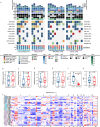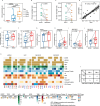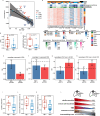Genomic and transcriptomic profiling of combined small-cell lung cancer through microdissection: unveiling the transformational pathway of mixed subtype
- PMID: 38383412
- PMCID: PMC10880258
- DOI: 10.1186/s12967-024-04968-4
Genomic and transcriptomic profiling of combined small-cell lung cancer through microdissection: unveiling the transformational pathway of mixed subtype
Abstract
Background: Combined small-cell lung carcinoma (cSCLC) represents a rare subtype of SCLC, the mechanisms governing the evolution of cancer genomes and their impact on the tumor immune microenvironment (TIME) within distinct components of cSCLC remain elusive.
Methods: Here, we conducted whole-exome and RNA sequencing on 32 samples from 16 cSCLC cases.
Results: We found striking similarities between two components of cSCLC-LCC/LCNEC (SCLC combined with large-cell carcinoma/neuroendocrine) in terms of tumor mutation burden (TMB), tumor neoantigen burden (TNB), clonality structure, chromosomal instability (CIN), and low levels of immune cell infiltration. In contrast, the two components of cSCLC-ADC/SCC (SCLC combined with adenocarcinoma/squamous-cell carcinoma) exhibited a high level of tumor heterogeneity. Our investigation revealed that cSCLC originated from a monoclonal source, with two potential transformation modes: from SCLC to SCC (mode 1) and from ADC to SCLC (mode 2). Therefore, cSCLC might represent an intermediate state, potentially evolving into another histological tumor morphology through interactions between tumor and TIME surrounding it. Intriguingly, RB1 inactivation emerged as a factor influencing TIME heterogeneity in cSCLC, possibly through neoantigen depletion.
Conclusions: Together, these findings delved into the clonal origin and TIME heterogeneity of different components in cSCLC, shedding new light on the evolutionary processes underlying this enigmatic subtype.
Keywords: Microdissection; Monoclonal origin; RB1; TP53; Transdifferentiation; Tumor immune microenvironment; cSCLC.
© 2024. The Author(s).
Conflict of interest statement
The authors have no declared competing interests or financial ties to disclose.
Figures






Similar articles
-
Comparative study of the genomic landscape and tumor microenvironment among large cell carcinoma of the lung, large cell neuroendocrine of the lung, and small cell lung cancer.Medicine (Baltimore). 2023 Jan 27;102(4):e32781. doi: 10.1097/MD.0000000000032781. Medicine (Baltimore). 2023. PMID: 36705391 Free PMC article.
-
Comprehensive genomic profiling of combined small cell lung cancer.Transl Lung Cancer Res. 2021 Feb;10(2):636-650. doi: 10.21037/tlcr-20-1099. Transl Lung Cancer Res. 2021. PMID: 33718010 Free PMC article.
-
Next-Generation Sequencing of Pulmonary Large Cell Neuroendocrine Carcinoma Reveals Small Cell Carcinoma-like and Non-Small Cell Carcinoma-like Subsets.Clin Cancer Res. 2016 Jul 15;22(14):3618-29. doi: 10.1158/1078-0432.CCR-15-2946. Epub 2016 Mar 9. Clin Cancer Res. 2016. PMID: 26960398 Free PMC article.
-
Typical and atypical carcinoid tumors of the lung are characterized by 11q deletions as detected by comparative genomic hybridization.Am J Pathol. 1998 Oct;153(4):1089-98. doi: 10.1016/S0002-9440(10)65653-2. Am J Pathol. 1998. PMID: 9777940 Free PMC article. Review.
-
[Mechanism of Histologic Transformation of Drive Gene Positive Lung Adenocarcinoma in Targeted Therapy and Treatment Strategy].Zhongguo Fei Ai Za Zhi. 2020 Aug 20;23(8):701-709. doi: 10.3779/j.issn.1009-3419.2020.102.22. Epub 2020 Aug 6. Zhongguo Fei Ai Za Zhi. 2020. PMID: 32758349 Free PMC article. Review. Chinese.
Cited by
-
Investigating lung cancer microenvironment from cell segmentation of pathological image and its application in prognostic stratification.Sci Rep. 2025 Jan 11;15(1):1704. doi: 10.1038/s41598-025-85532-y. Sci Rep. 2025. PMID: 39799232 Free PMC article.
References
-
- Bray F, Ferlay J, Soerjomataram I, Siegel RL, Torre LA, Jemal A. Global cancer statistics 2018: GLOBOCAN estimates of incidence and mortality worldwide for 36 cancers in 185 countries. CA Cancer J Clin. 2018;68(6):394–424. - PubMed
-
- Chen W, Zheng R, Baade PD, Zhang S, Zeng H, Bray F, Jemal A, Yu XQ, He J. Cancer statistics in China, 2015. CA Cancer J Clin. 2016;66(2):115–132. - PubMed
-
- van Meerbeeck JP, Fennell DA, De Ruysscher DK. Small-cell lung cancer. Lancet. 2011;378(9804):1741–1755. - PubMed
Publication types
MeSH terms
Grants and funding
LinkOut - more resources
Full Text Sources
Medical
Research Materials
Miscellaneous

